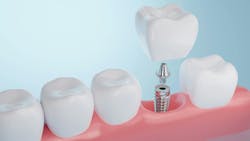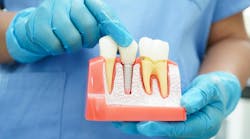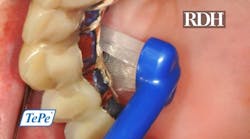Dental hygienists report on dental implant maintenance experience, education, and protocols: How do you measure up?
What you'll learn in this article
- Why implant cases are increasing and how dentistry is evolving.
- How hygienists’ implant care education still lags behind demand.
- What recent survey data reveals about current implant care knowledge.
- The impact of peri-implant disease and importance of early detection.
- Strategies to close the implant education gap for hygienists.
Admit it: you’re seeing more patients with implants. The US Dental Implants Market was valued at USD $4.43 billion in 2023 and is projected to reach USD $5.89 billion by 2029.1 More dentists are placing and restoring dental implants. This surge can be attributed to advancements such as computer-aided design for case planning software, the use of printed surgical guides, and innovations in the manufacturing of final restorations. These developments have increased predictability, affordability, and access to education in placement and restorative techniques.
Despite the industry's growth, formal education for dental hygienists regarding implant maintenance has not kept pace. In 2012, the Journal of Dental Hygiene published a survey that gauged the knowledge and clinical approach of practicing dental hygienists regarding dental implant maintenance. Of the 213 respondents, only 25 reported receiving training on implant care during dental hygiene school.2
Ivy Zelmer published an insightful article in 2020 summarizing the impressions and treatment modalities of dental hygienists for maintaining dental implants. Of the 2,033 US dental hygienists surveyed, more than 90% of those in general practice settings reported a lack of knowledge about how to properly care for patients with dental implants. Simply put, it’s not uncommon for a hygienist to express a lack of confidence in how to assess and address peri-implantitis.3
This is concerning since preventive maintenance and the role of dental hygienists in early peri-implant disease detection have been globally recognized as the foundation for implant health and long-term success. It is reported that 10%–20% of implants display signs of peri-implantitis after 15 years.4
To further explore hygienists' access to education on implant maintenance in the past five years, a survey was conducted in the fall of 2024. An online survey was distributed via email and shared on social media platforms by influencers and in state-specific dental hygiene Facebook groups. The survey was also promoted at the author’s continuing education events.
Survey participant responses and insights
A total of 576 participants completed the survey, representing states in the Northeast, Mid-Atlantic, South, West Coast, and Middle America. The participants graduated between 1959 and 2024.
The responses provided insights into the various practice settings where hygienists work and the extent to which they offer implant care services:
- 44.7% reported working in an office with three to five hygienists
- 27% worked in an office with two hygienists
- 14% were the only hygienist in their office
- 14% worked in an office with five to 10 hygienists
Regarding implant placement, of the 449 who responded to this question, 48.7% (218 hygienists) reported that implants were surgically placed in their office. The remaining 51.3% (231 respondents) reported that their office only restores implants and refers patients to a specialist for surgical placement.
Hygienists who work with specialists who place implants were surveyed:
- 12% (52 out of 415 hygienists) reported working full-time with a periodontist
- 242 out of 458 reported working in an office with a general dentist who places implants
With full arch cases, of the 576 respondents:
- 144 (26.2%) reported their office sees 25 to 100 full arch prosthetic cases annually
- 37 (6%) reported their office sees more than 200 full arch cases per year
With single implant cases, among the 509 respondents to this question:
- 203 (40%) reported their office places fewer than 25 single implant cases annually
- 160 (31.5%) reported 25 to 100 cases
- 111 (21.7%) reported 100 to 200 cases
- 35 (6.9%) reported more than 200 cases
Hygienists are seeing more patients with implants:
- 25 of the 509 respondents reported seeing two or fewer patients with implants per month.
- 200 of the 509 responses reported four or more patients with implants per week.
A significant increase in formal education on dental implant maintenance was observed. Of the 485 respondents to this question:
- 57.4% reported receiving formal education on implant maintenance
- 42.6% reported no formal education
This contrasts with earlier data, such as the 2012 survey where only 11% reported formal dental implant education during school. The newer survey, however, did not specify whether the education was received in school or via continuing education.
Next steps and considerations
Many manufacturers provide education about dental implant maintenance, highlighting their company’s product line. While there is notable progress in hygienists receiving formal training on implant maintenance compared to the 2012 study, the fact is that nearly half of hygienists seeing patients still lack formal education. State dental hygiene licensing boards may consider mandatory implant maintenance training for license renewal.
As peri-implant disease threatens implant longevity, it is vital for all hygienists to be equipped with up-to-date education on dental implant maintenance. Enhanced training on the early identification of peri-implant disease and prevention protocols, including implant-safe biofilm removal techniques, will improve patient outcomes and contribute to the long-term success of dental implants.
References
1. Dental implants market outlook 2024-2029: demand for non-premium dental implants is growing as more patients seek affordable solutions for tooth replacement. Globe Newswire. January 3, 2025. https://www.globenewswire.com/news-release/2025/01/03/3003868/28124/en/Dental-Implants-Market-Outlook-2024-2029-Demand-for-Non-premium-Dental-Implants-is-Growing-as-More-Patients-Seek-Affordable-Solutions-for-Tooth-Replacement.html
2. Ward ST, Czuszak CA, Thompson AL, Downey MC, Collins MA. Assessment and maintenance of dental implants: clinical and knowledge-seeking practices of dental hygienists. J Dent Hyg. 2012;86(2):104-110.
3. Zellmer IH, Couch ET, Berens L, Curtis DA. Dental hygienists' knowledge regarding dental implant maintenance care: a national survey. J Amer Dent Hyg Assn. 2020;94(6):6-15.
4. Zahng TT, Hu XJ, Lin L. [Prevalence of peri-implantitis and peri-implant mucositis within 15 years of implant placement]. [Article in Chinese]. Shanghai Kou Qiang Yi Xue. 2021;30(3):292-296.
About the Author
Lynn Pencek, MS, RDH
Lynn Pencek, MS, RDH, has a unique balance of industry knowledge and clinical experience. As a member of the Nobel Biocare team, she helped dental implant teams develop efficient patient care workflows. As a dental hygienist, Lynn wanted to unravel the common questions and misunderstandings dental hygienists have about implant care and maintenance. She is the founder of Practice at Your Best, Learn more at practiceatyourbest.com or contact her at [email protected] .


